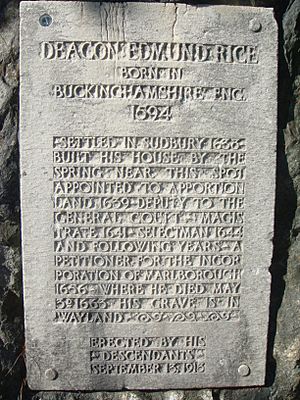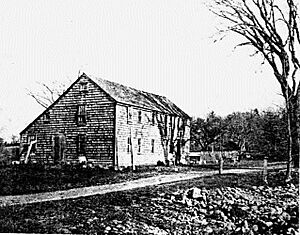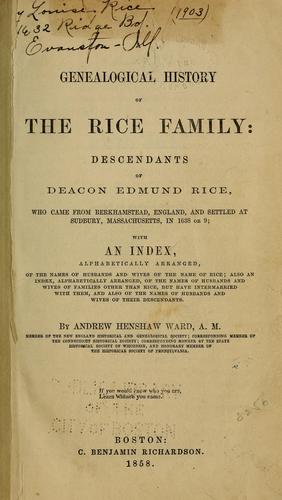Edmund Rice (colonist) facts for kids
Quick facts for kids
Edmund Rice
|
|
|---|---|

Edmund Rice homesite marker tablet in Wayland, Massachusetts.
|
|
| Deputy of the Great and General Court of the Massachusetts Bay Colony | |
| In office 1640, 1643, 1652 – 1654 |
|
| Selectman Sudbury, Massachusetts | |
| In office 1639, 1640, 1644 – 1656 |
|
| Judge of Small Causes Sudbury, Massachusetts | |
| In office 1641–1655 |
|
| Selectman Marlborough, Massachusetts | |
| In office 1657–1663 |
|
| Personal details | |
| Born | c. 1594 Suffolk, England |
| Died | 3 May 1663 (aged 69) Marlborough, Massachusetts |
| Resting place | Old North Cemetery, Wayland, Massachusetts 42°22′15″N 71°22′09″W / 42.370942°N 71.369048°W |
| Relatives | full list |
| Profession | Yeoman farmer, Surveyor, Land owner, Deacon of Puritan Church |
Edmund Rice (born around 1594 – died May 3, 1663) was an important early settler in the Massachusetts Bay Colony. He came from Suffolk, England, with his family in 1638. He helped found the towns of Sudbury and Marlborough.
Edmund Rice was a deacon in the Puritan Church. He also served in local government as a selectman (a town official). He was a judge and spent five years as a member of the Great and General Court. This was the main government body for the colony.
Contents
Who Was Edmund Rice?
Edmund Rice was likely born in Suffolk, England, around 1594. We know this because he said he was 62 years old in a court document from 1656. Many old church records from that time are missing. So, we don't know the exact date of his birth or his parents' names.
We know more about his early life from his children's baptism records. He also owned land in Stanstead, Suffolk and Berkhamsted, Hertfordshire. He moved from Stanstead to Berkhamsted in 1626.
Edmund's Role in England
In Berkhamsted, Edmund Rice helped manage a grant of money from King Charles I. This money was meant to help the poor. He also served as a churchwarden at St. Peter's Church. For eight years, he was an overseer of the poor. This meant he helped look after people who needed support.
He owned land in Berkhamsted and paid taxes on it. By 1638, there is no record of him paying land taxes. This suggests he might have sold his land to pay for his trip to America.

Journey to America
There are no records of Edmund Rice's trip to America. Historians believe he traveled between March and September of 1638. His son Joseph was baptized in England in March. By September, Edmund was in Watertown, Massachusetts. He was among those who asked to start the town of Sudbury.
The first official record of him in Massachusetts is from April 1639. He was already serving as a selectman in Sudbury. This shows he quickly became a leader in the new community.
Edmund Rice's Life in Colonial Massachusetts
From 1638 to 1657, Edmund Rice lived in Sudbury. He became a very important person there. He owned a lot of land, more than anyone else in Sudbury. He also represented the town in the Massachusetts legislature for five years. For many years, he served as a selectman and a judge.
Public Service in Sudbury
In 1639, the General Court asked him to help plan Sudbury's roads and land lots. He was given 4 acres of land near the first meetinghouse. In 1640, he received another 20 acres. This land was in southeastern Sudbury, near the Old Connecticut Path.
He was a selectman in Sudbury from 1639 to 1640, and again from 1644 to 1656. In 1640, he became a freeman. This meant he could vote and hold office. He was elected as a deputy (representative) to the Great and General Court in October 1640.
In 1641, he became a Judge of Small Causes for Sudbury. He held this job until 1648. After that, he was elected as a municipal judge until 1654. He was re-elected as a deputy to the General Court in 1643, 1652, 1653, and 1654.
In 1648, Edmund Rice became a Deacon in the Puritan Church in Sudbury. He also helped settle land disputes between towns. For example, he helped survey land for Harvard College and for John Stone.
Land Ownership and Influence
Edmund Rice was very good at buying and selling land. In 1642, he sold his first homestead in Sudbury. He then moved to his 20 acres of land near the Old Connecticut Path. Other families from his old town in England, like Philemon Whale and Thomas Axtell, settled nearby.
He bought back land from Thomas Axtell's estate after Axtell passed away. In 1657, he bought the 200-acre "Jennison Farm." By 1659, he owned about 600 acres in southeastern Sudbury. This area is now Wayland and Cochituate.
The General Court also gave him land grants in what is now Framingham. These lands were later passed to his son Henry and became known as Rice's End.
Founding Marlborough
In England, there was a debate about how land should be farmed. Some people preferred "open-field" farming, where land was shared. Others liked "closed-field" farming, where individuals owned their land. Edmund Rice and twelve other people from Sudbury preferred closed-field farming.
In 1656, they asked the Great and General Court to create a new town. This town was Marlborough. In Marlborough, people would own their farmland individually. This was a big step in establishing private land ownership in America.
The new town was 8 square miles. It later became Northborough, Westborough, Southborough, and Hudson. Edmund Rice was elected as a selectman in Marlborough in 1657. The town officially became a town in 1660. He was one of the largest landowners in Marlborough. He was re-elected as selectman every year until he died.
Edmund Rice died on May 3, 1663, in Marlborough, Massachusetts. He is likely buried at the Old North Cemetery in Wayland, Massachusetts. His estate was worth a lot of money for that time. It included land and homes in both Sudbury and Marlborough.
The only item known to have belonged to Edmund Rice and his second wife, Mercy Brigham Rice, is an old bible box. Mercy brought it from England in 1635. It is now at the Worcester Historical Museum.
Edmund Rice's Family
Edmund Rice married Thomasine Frost (1600–1654) on October 15, 1618. They were married at St. Mary's Church in Bury St. Edmunds, Suffolk, England. They had 10 children:
- Mary Rice, baptized August 23, 1619.
- Henry Rice, baptized February 13, 1621. He died in 1711 in Framingham. Henry was among the first people to get a house lot in Sudbury. He and his family were early European settlers of Framingham.
- Edward Rice, baptized October 20, 1622. He died in 1712 in Marlborough. Edward was one of the first people to live in Marlborough. He was a deacon at the First Parish in Marlborough.
- Thomas Rice, baptized January 26, 1626. He died in 1681 in Sudbury. Thomas was also one of the first people in Marlborough. His home was a strong garrison house during King Philip's War (1675–78).
- Lydia Rice, baptized March 9, 1628. She died in 1675 in Boston. She married Hugh Drury, a carpenter.
- Matthew Rice, baptized February 28, 1629. He died in 1717 in Sudbury. Matthew lived on the "Jennison Farm" land that Edmund bought.
- Daniel Rice, baptized November 1, 1632. He died shortly after in 1632.
- Samuel Rice, baptized November 12, 1634. He died in 1685 in Marlborough. Samuel was one of the first people in Marlborough. He served in the Massachusetts Militia during King Philip's War.
- Joseph Rice, baptized March 13, 1638. He died in 1711 in Stow. Joseph was one of the first people in Marlborough. His home was also a garrison house during King Philip's War. He served as a representative in the Massachusetts General Court.
- Benjamin Rice, born May 31, 1640, in Sudbury. He died in 1713 in Sudbury. Benjamin was also one of the first people in Marlborough.
After Thomasine died in 1654, Edmund Rice married Mercy Brigham (around 1616-1693) on March 1, 1655. Mercy was a widow. This marriage connected the Rice and Brigham families. Edmund and Mercy had two daughters:
- Lydia Rice, born around 1657 in Sudbury. She died in 1718.
- Ruth Rice, born September 29, 1659, in Marlborough. She died in 1742 in Glastonbury, Connecticut.
Edmund Rice's Descendants
People who are descendants of Edmund Rice have been meeting since 1851. In 1858, Andrew Henshaw Ward published a book about the Rice family's genealogy. This book listed over 6,200 descendants and their spouses.
In 1912, the Edmund Rice (1638) Association (ERA) was formally started. This group was led by Nellie Rice Fiske, a school teacher. They worked to raise money for monuments at Edmund's homesite and cemetery.
Researching the Family Tree
The ERA continued to research and document Edmund's descendants. In the 1930s, Alexander Hamilton Rice, Jr. asked genealogist Mary Lovering Holman to update the family history. Her research helped people understand Edmund's roots in England.
The ERA started publishing a quarterly newsletter in 1960. By 1968, they had found and confirmed 26,000 descendants. By 2017, their electronic database had over 260,000 individuals. It's estimated that Edmund has about 4.4 million descendants in the first twelve generations.
In 1980, Corinne M. Snow, an Edmund Rice descendant, wrote a historical fiction book called The Deacons. It tells the story of the Rice family from England to their life in Massachusetts. It covers their immigration and experiences during King Philip's War.
Genetic Family History

Since 2000, the ERA has used DNA testing to learn more about Edmund Rice's male descendants. They have collected enough data to figure out Edmund's Y-DNA. This DNA information supports that he was born in Suffolk, England. It also helps correct old claims that he was related to Welsh royalty.
The DNA tests also confirmed some family lines where the surname changed. For example, some people with the last name King are direct male descendants of Edmund Rice. This happened with Samuel Rice (1667-1713), who became known as Lt. Samuel Rice King. Famous descendants include U.S. Senator William H. King and his son, U.S. Congressman David S. King.
Similarly, some people with the last name Royce also have the same Y-DNA as Edmund Rice. This confirms a name change by Alpheus Rice (1787-1871), who became Capt. Alpheus Royce.
Mohawk Connection
The genetic testing also showed that some male members of the Mohawk nation with the surname Rice share Edmund Rice's Y-DNA. This is likely because of an event during Queen Anne's War.
On August 8, 1704, an Indian raid captured four Rice boys from Marlborough. They were taken to Kahnawake, Canada. There, they were adopted and raised by Mohawk families. They became part of the Mohawk community and married local women. One of these boys was Silas Rice.
Actress Alexandrea Kawisenhawe Rice, who is Mohawk, is a descendant of Edmund Rice through his great-grandson Silas.
Images for kids
-
Edmund Rice homesite marker tablet in Wayland, Massachusetts.
-
Edmund Rice Homestead built about 1643 by Rice in saltbox style by the spring feeding the Sudbury River near the Old Connecticut Path in southeastern Sudbury (now Wayland). It stayed in the Rice family many generations until it burned down sometime around 1910.
-
Plaque memorializing the death of one and capture of four Rice boys from a flax field in Marlborough (later to become Westborough) with the inscription, "In the Field South of this Spot 8 August 1704 Indians Killed Nahor and Captured Ashur, Adonijah, Silas and Timothy Rice."









